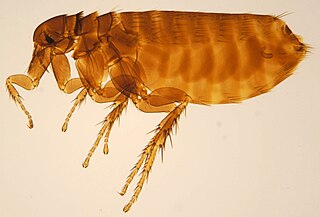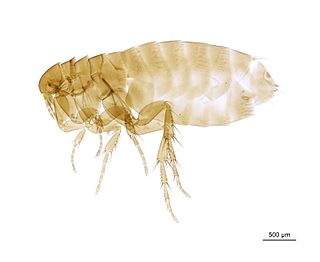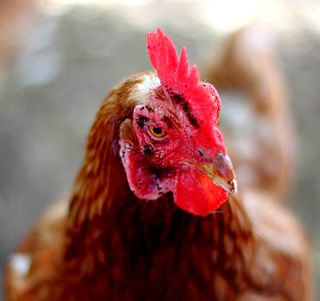
Flea, the common name for the order Siphonaptera, includes 2,500 species of small flightless insects that survive as external parasites of mammals and birds. Fleas live by consuming blood, or hematophagy, from their hosts. Adult fleas grow to about 3 millimetres long, are usually brown, and have bodies that are "flattened" sideways or narrow, enabling them to move through their host's fur or feathers. They lack wings, but have strong claws preventing them from being dislodged, mouthparts adapted for piercing skin and sucking blood, and hind legs extremely well adapted for jumping. They are able to leap a distance of some 50 times their body length, a feat second only to jumps made by another group of insects, the superfamily of froghoppers. Flea larvae are worm-like with no limbs; they have chewing mouthparts and feed on organic debris left on their host's skin.

The common moorhen, also known as the waterhen or swamp chicken, is a bird species in the rail family (Rallidae). It is distributed across many parts of the Old World.

The common gallinule is a bird in the family Rallidae. It was split from the common moorhen by the American Ornithologists' Union in July 2011. It lives around well-vegetated marshes, ponds, canals, and other wetlands in the Americas. The species is not found in the polar regions or many tropical rainforests. Elsewhere, the common gallinule is likely the most commonly seen rail species in much of North America, except for the American coot in some regions.

Lionel Walter Rothschild, 2nd Baron Rothschild, Baron de Rothschild, was a British banker, politician, zoologist and soldier, who was a member of the prominent Rothschild family. As a prominent Zionist leader, he was presented with the famous Balfour Declaration which pledged to a Jewish national home in Palestine. Rothschild was the president of the Board of Deputies of British Jews from 1925 to 1926.

Dame Miriam Louisa Rothschild was a British natural scientist and author with contributions to zoology, entomology, and botany.

The Oriental rat flea, also known as the tropical rat flea, is a parasite of rodents, primarily of the genus Rattus, and is a primary vector for bubonic plague and murine typhus. This occurs when a flea that has fed on an infected rodent bites a human, although this flea can live on any warm blooded mammal.

The moorhen flea is a flea originating from South America. It is now globally widespread. It is a large flea, easily identified because the male has two heavy horn-like spines on one of the genital flaps, and the female has a deep "bite" on the seventh sternite.

Ceratophyllus gallinae, known as the hen flea in Europe or the European chicken flea elsewhere, is an ectoparasite of birds. This flea was first described by the German botanist and entomologist Franz von Paula Schrank in 1803.

Pulex is a genus of fleas. It comprises seven species. One is the human flea, and five of the others are confined to the Nearctic and Neotropical realms.

Ceratophyllus borealis , also known as the boreal flea, is an ectoparasite of birds. It is a black species found on ground-nesting birds such as pipits, wheatears and wagtails.
Syngamus merulae is a parasitic nematode worm infecting the tracheas of birds including thrushes. It is closely related to the gapeworm, Syngamus trachea.

Ceratophyllus is a widespread genus of fleas found in temperate climates. Some of its members include the chicken flea, Ceratophyllus gallinae, and the poultry flea, Ceratophyllus niger.
Dasypsyllus aemulus is a species of flea in the family Ceratophyllidae. It was described by Karl Jordan in 1933.
Dasypsyllus comatus is a species of flea in the family Ceratophyllidae. It was described by Karl Jordan in 1933.
Dasypsyllus lasius is a species of flea in the family Ceratophyllidae. It was described by Rothschild in 1909.
Dasypsyllus araucanus is a species of flea in the family Ceratophyllidae. It was described by Karl Jordan and Charles Rothschild in 1920.
Dasypsyllus cteniopus is a species of flea in the family Ceratophyllidae. It was described by Karl Jordan and Charles Rothschild in 1920.
The hedgehog flea is a flea species which, as indicated by its common name, is an external parasite specifically adapted to living with the European hedgehog and the North African hedgehog, but it has also been found on other animals.

Echidnophaga is a genus of fleas. It includes species which are found in Africa, parts of Asia, southern Europe, and Australia. Fleas in this genus remain attached to their host in a single location for long periods of time, causing swelling and ulceration of tissue. To remain attach for long periods they use specialized mouthparts, which, compared to other fleas, are relatively much longer.
Hectopsylla is a genus of fleas in the family Hectopsyllidae that parasitize non-volant mammals, birds, and bats. The genus comprises thirteen species, six of which were described in whole or part by Karl Jordan between 1906–1942. Two of the species in Hectopsylla, H. psittaci and H. pulex, go under common names, with H. psittaci identified as the sticktight flea and H. pulex identified as the chiggerflea. Hastritter and Méndez (2000) consider the genus Rhynchopsyllus a junior system of the genus.










